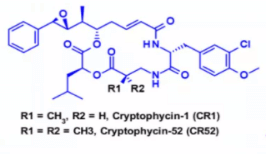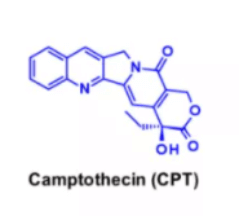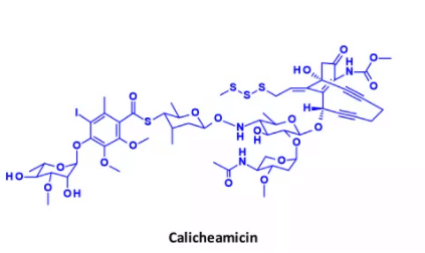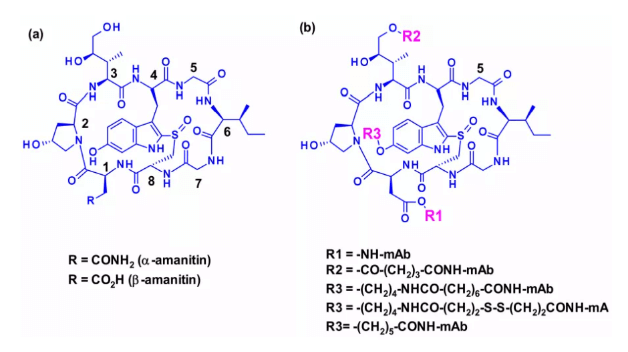Main elements of antibody-drug conjugate (ADC):Toxins/Payloads (Classification and function)
There are so many payloads, like MMAE, Calicheamicin, MMAF, DM1, SN-38 and Dxd.
Microtubule destroying drug
1. Calendula
Auristatins is an important payload used in ADC. The most famous family member MMAE exists in two listed drugs, adcetris and Polivy. At present, more than 10 kinds of ADCs with calendula (such as MMAE) or methylcalendula f (MMAF) as payload are undergoing clinical trials.

The figure above describes auristatine and its common connection sites. The structure-activity relationship (SAR) of Calendula has been widely studied, mainly focusing on the terminal subunit: P1 (N-terminal) and P5 (C-terminal). The most common method is to introduce carbamate function on P1.
2. Meidengsu derivatives (DM2, DM4)
Metanthin is a very effective inhibitor of microtubule assembly, which can induce the cessation of cell mitosis. However, this structure is difficult to conjugate because it has no reactive functional groups. In order to overcome this problem, a series of very effective derivatives containing SME groups have been created. The first examples of such molecules are DM1 and DM4, which carry methylthiopropionyl rather than natural N-acetyl groups.

3. Microtubule lysin
Tubulysins is an effective inhibitor of microtubule polymerization, which can lead to the rapid disintegration of the cytoskeleton of dividing cells and apoptosis. They are a naturally occurring tetrapeptide family containing Mep, Ile, Tuv and Tut, R3 = OH or Tup, R3 = H.

4. Cryptomyxin
Cryptomyxin (CR) is a family of six membered macrocyclic dipeptides with antitumor activity. The results of existing clinical trials show that the toxicity level is unacceptable at the dose required to achieve the therapeutic effect.

5. Anti-mitotic Eg5 inhibitor
Spindle kinesin (KSP, also known as Eg5 or kif11) is an ATP dependent motor protein involved in the separation of cell cycle centrosomes. Therefore, blocking this important event in mitosis with KSP inhibitors (kspis) can produce antitumor efficacy.
DNA damage drugs
1. Pyrrole benzodiazepines and indole chlorobenzodiazepines
Pyrrolo [2,1-c] [1,4] benzodiazepine (PBD) is a natural product with antitumor activity. Their mode of action is selective alkylation in small grooves of DNA, in which the N2 of guanine forms a covalent bond with the electrophilic N10 / C11 imine on PBD.
2. Ducamycin
Ducamycin is a powerful cytotoxic substance. It binds to the small groove of DNA through its highly active cyclopropane ring and alkylates adenine at N3 position. The non cyclized, halomethyl form of ducamycin significantly reduced its cytotoxic activity. Because the phenol group in the molecule can be used as the racemic activator to form electrophilic cyclopropane, the ligation strategy in the development of ducamycin ADC focuses on the linker ligation of phenol functional groups.
3. Camptothecin
Camptothecin (CPT) and its derivatives are classic examples of topoisomerase I inhibitors. They stabilize DNA single strand breaks induced by topoisomerase, and DNA double strand breaks occur when the ternary dna-top1-inhibitor complex encounters the replication fork. Natural camptothecin is a five ring structure. Its very low solubility prevents its wide application as a cancer therapeutic drug. Irinotecan, its water-soluble prodrug, has been licensed for the marketing of metastatic colorectal cancer. SN-38 is an active metabolite of irinoteptan. It is produced in vivo by the action of human liver carboxylesterase, which can be inactivated by opening the lactone ring.

4. Kajimycin
Kajimycin is a widely studied class of enediyne antibiotics. Its structure and mechanism of action are particularly interesting and complex, making it a class of antibiotics in the field of ADC payload. The strategy of connecting calicheamicin in ADC takes ADC Mylotarg in the market as an example, and besponsa.

Innovative drugs
1. Apoptosis inducer (BCL XL inhibitor)
Overexpression of anti apoptotic Bcl-2 family members (including BCL XL) is one of the mechanisms for cancer cells to obtain apoptosis resistance. Drugs that block the BH3 binding domain on BCL XL can trigger cancer cell apoptosis.
2. Telanstadine and its analogues
Targeted spliceosome is a large ribonucleoprotein complex involved in mRNA processing, which provides a promising treatment option for targeted cancer therapy. Several natural products can inhibit RNA splicing by binding to different splice subunits. The most representative is thailanstatin A, which can bind to the SF3B subunit of spliceosome to prevent RNA splicing.

3. Amanita toxin
In the field of ADC technology, the use of transcription inhibitors similar to Amatoxins is a relatively new method. Nine naturally occurring amatoxin derivatives have the same skeleton structure. A macrocycle composed of eight L-configuration amino acids is partially connected between tryptophan and cysteine residues by sulfoxide. The three side chains of Amatoxins are hydroxylated, and the OH group has good water solubility and binds to the target molecule. Two peptides, α- Amanita glycoprotein and β- Amanita toxin accounts for 90% of all toxins.

4. Nicotinamide phosphoribosyltransferase
Nicotinamide phosphoribosyltransferase (Nampt) is an enzyme responsible for converting nicotinamide to nicotinamide mononucleotide. Its inhibitor has shown effectiveness in various preclinical and clinical studies, but its clinical application is limited by targeted toxicity and dose limiting toxicity, such as thrombocytopenia and gastrointestinal adverse reactions.
5. Camamycin
Two new protease inhibitors, camamycin A and camamycin B, were isolated from Curacao bacteria.







 View the Knowledge base of Antibody-drug Conjugate (ADC):
View the Knowledge base of Antibody-drug Conjugate (ADC):